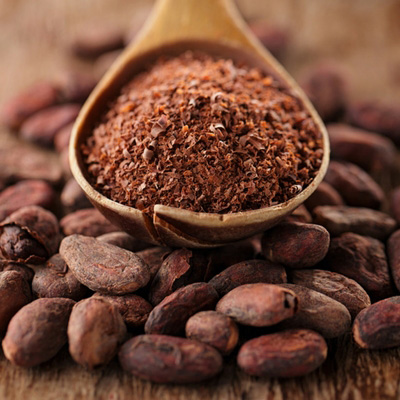T K

644 Main Road
Eltham Victoria 3095 AU
03 9439 8650
reception@elthamvet.com.au

Chocolate toxicity
Pets are commonly exposed to chocolate particularly around holidays such as Easter, Halloween and Christmas.
Overview
Chocolate and cocoa products found in lollies, cakes, cookies, brownies, and baking products are highly attractive to pets. They contain toxic compounds referred to as methylxanthines such as theobromine and caffeine that can cause severe illness. The amounts of toxic compounds vary greatly between products with dark chocolate, baking chocolate, and cocoa powder holding the highest concentrations.
Toxic doses of theobromine*
| Mild illness | 20mg/kg |
| Moderate to serious | 40mg/kg |
| Lethal | 100-200mg/kg |
*Pets can respond differently to chocolate doses and the type of chocolate ingested, with some dogs more sensitive than others.
Levels of theobromine
|
Cocoa contains 20-30mg/g of theobromine
|
|
Baking chocolate or dark chocolate contains 6-16mg/g of theobromine
|
|
Milk chocolate contains 2mg/g of theobromine
|
|
White chocolate contains 0.1mg/g of theobromine
|
Calculating the chocolate dose
You will need to know:
- Pet's weight (kgs)
- Amount of chocolate ingested in grams or ounces
- Estimated concentration of theobromine
To get the mg/kg dose of chocolate:
- Multiply the chocolate bar's amount in grams by the concentration of theobromine
- Divide this number by the pet's weight
Examples
|
Milk chocolate toxicity 15kg dog Ingests 85g milk chocolate bar Milk chocolate concentration is 2mg/g |
85 x 2 = 170 mg 170/15 = 11.33 mg/kg You would expect a dose of < 20mg/kg should only cause mild tummy upset in most dogs |
|
Dark chocolate toxicity 15kg dog Ingests 85g dark chocolate bar Dark chocolate concentration is approximately 16mg/g |
85 x 16 = 1,360 mg 1,360/15 = 90.66 mg/kg You would expect a dose above 40mg/kg to cause serious illness in most dogs. |
Estimated doses of chocolate toxicity**
| Size of dog | Milk Chocolate | Dark or Baking Chocolate |
| Small dogs | 60-600g | 7-70g |
| Medium dogs | 900g-1.5kg | 100-200g |
| Large dogs | 2kg+ | 200-500g |
**The amount of theobromine and caffeine will differ between chocolate brands. Always call your veterinary practice and advise them of the amount of chocolate ingested. They will be able to accurately calculate the dose that your pet has been exposed to.
Signs
Common signs of chocolate toxicity:
- Twitching
- Vomiting
- Diarrhea
- Panting
- Bloat
- Restlessness
- Tremors
- Seizures
- Heart arrhythmias
- Respiratory failure
Clinical signs usually occur within 6-12 hours of eating the chocolate and can persist for 72 hours in severe cases.
The half-life of theobromine is 17.5 hours and caffeine is 4.5 hours, which means that it takes that amount of time for half of it to be excreted out of the body.
Management
Your veterinarian will determine the amount of theobromine and caffeine ingested. So, it is important to recall the type and amount of chocolate your pet has ingested. Chocolate ingestion can be a serious problem that requires urgent veterinary attention.
Treatment may include:
- Induced vomiting and removal of gastrointestinal contents
- Stabilization and supportive care with fluids
- Medication for tremors or seizures
Depending on the level of toxic compounds ingested, most pets will make a full recovery with aggressive veterinary treatment.
Prevention
Tips to help prevent chocolate toxicity:
- Keep chocolate out of reach of pets
- Look for dog treats with carob (a chocolate alternative with no theobromine or caffeine)
References
Beasley V.R., et al: A Systems Affected Approach To Veterinary Toxicology. University of Illinois College ed. . of Veterinary Medicine, Urbana, IL, pp. 116-120, 1999.
Boothe, D.M.: Anticonvulsant drugs and analeptic agents. In: Veterinary Pharmacology and Therapeutics7th ed. H.R. Adams, ed. Iowa State University Press, Ames, IA, pp. 387-388, 1995.
Drolet R., et. al: Cacao bean shell poisoning in a dog. J. Am. Vet. Med. Assoc. Vol 185(8): 902, 1984.
Finlay F. Chocolate poisoning. BMJ 2005 Sep 17, 331(7517):633
Hooser S.B., Beasley VR.: Methylxanthine poisoning (chocolate and caffeine toxicosis). In: Current Veterinary Therapy for Small Animal Practice IX. WB Saunders, Philadelphia, PA, pp. 191-192, 1986. rd
Plumb D.C.: Veterinary Drug Handbook, 3 ed. Iowa State University Press, Ames, IA, pp. 118; 424, 1999.
Serafin, W.E.: Drugs used in the treatment of asthma. In: Goodman and Gilman’s The Pharmacologic the Basis of Therapeutics, 9th edJ.G. Hardman, et al, eds. McGraw Hill, New York, NY, pp. 672-678, 1996



